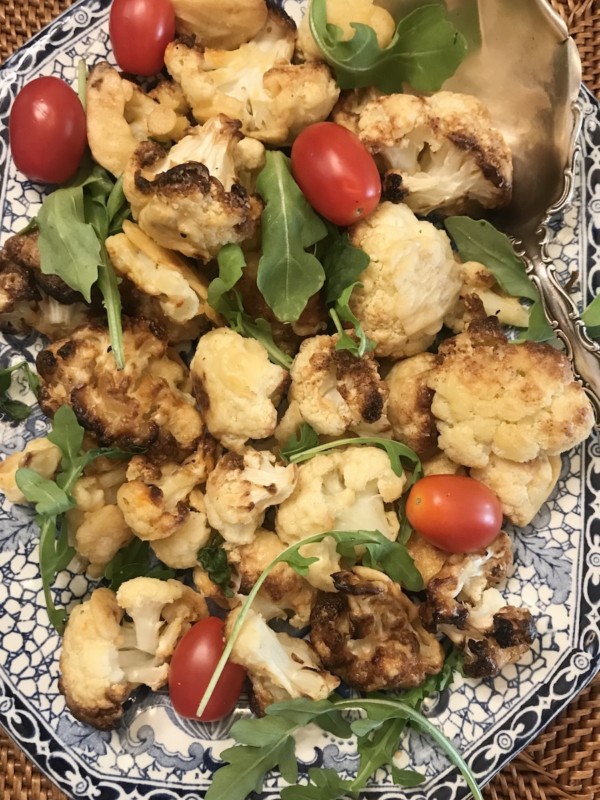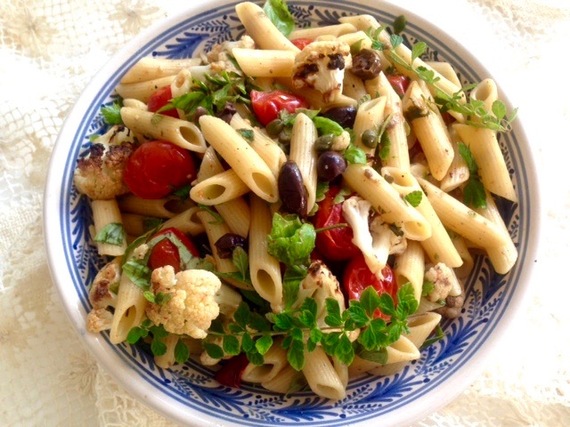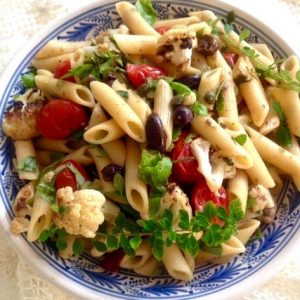Sweet, juicy tomatoes, salty, sexy olives and capers and fresh green herbs — these flavors of the Mediterranean come together in this easy pasta dish. Pantestcan pasta is one of my summer favorites, and a perfect way to celebrate Mediterranean Diet Month.

The Mediterranean Diet is a heritage diet that comprises whole foods like fresh produce, beans nuts, seeds, whole grains, even — swoon — pasta, not to mention a generous pour of olive oil.
This recipe shows why the Mediterranean Diet is still #1.
Stick around for some soulful, arcane information or jump to the recipe here.
Jump to RecipeWhere Does Pantescan Pasta Come From?
Pantescan means from the secluded island of Pantelleria — between Siciiy and Tunisia. The location may be remote, but you’ll recognize all the bold flavors conjured in this pasta.
Ingredients in Patescan Pasta
- Cauliflower — Sicily is famous for its sweet, abundant cauliflower — and it’s still pretty good here in the States. Enjoy this excellent crucifer in all its glory, from floret to core. Just chop the thick center into pieces, so you use every bit, with nothing wasted. I think of cauliflower as a value add, it’s mild-flavored and versatile, super-low in calories, but sky-high in vitamin C. Who knew? It imparts vegetable goodness to this and another favorite pasta dish.
- Capers — When I was little, I thought a dish served with capers meant the cook or waiter would dance. I discovered there was no dancing, just these little salty things in my food. Since then, I’ve learned capers are fruit, botanically speaking, and Pantelleria is famous for them. Capers begin their lives as berries that come from a hearty shrub that thrives on this arid island. They’re picked, then pickled in salt or brine. A scattering of capers imparts a natural, fish-free flavor of the sea.
- Olives— Surprise, they’re fruit, too, rich in antioxidants and fun, healthy fats. Green and black olives are actually the same fruit harvested at different stages of ripening. Green olives are picked underripe, they’re firm and sharp in taste. Black olives are sun-ripe and ready. Kalamatas, the olives in this recipe, are considered red or midway olives.They’re softer and more mellow-tasting than green olives, but not as mild as black olives. Of course brining the olives also impacts their flavor.
- Tomatoes — Yep, tomatoes are also fruit, botanically speaking. And they’re one of the Magic 8 , the core crops gifted to the world by our Indigenous Americans. But boy, did the Italians take to tomatoes. Their name for them is pomodoro — golden apple.
These Pantescan fruits all come together with Sicilian cauliflower for an easy but primal pasta dish.

Preparation
- Roast the vegetables. Roasting the cauliflower and tomatoes caramelizes their sugars, concentrates their flavors — and makes life easy for you. Just spread the vegetables on a rimmed baking sheet give them a splash of olive oil, white wine or vegetable broth, and pop them in a 400-degree oven for 20 minutes. Vegetables may get a slight char on them — that’s a good thing.
If you’re used to pasta drowning in sauce, this recipe will be a revelation. Roasting releases some of the juices from the cauliflower and tomatoes. They becomethe sauce, along with the capers, olives, and a fragrant handful of fresh basil, thyme, and Italian flat-leaf parsley.
For extra ease, roast vegetables a few hours ahead. Keep them covered. Then all you need to do is cook the pasta and toss everything together. - Cook the pasta. I recommend using a shorter pasta for this recipe. I like a twisty shape like fusiilli or rotini, because of my twisted sensibility. I’ve recently fallen for ZENB www.zenb.com, a high performing pasta made entirely from yellow peas, so it’s high in protein and fiber and gluten-free. Other faves include whole grain options from Barillla, and if I’m feeling fancy, artisanal brand Pasta Felicetti.
Make pasta according to package directions. But test/taste a minute or two before suggested cooking time. Pasta is meant to be al dente — to the tooth, so you can bite through it. It shouldn’t crunch, but it shouldn’t be mush, either.
Drain pasta but save the pasta water. This is a classic Italian technique that may sound crazy but trust me, it takes your pasta to the next level. Pasta is thirsty, even after cooking, even after tossing in sauce. Finishing your dish by adding back some of the starchy pasta cooking water helps helps hug the sauce tot he pasta, and gives it a little more oomph. We could all use a little oomph.
More Pasta Recipes You’ll Love
- Not Your Nonna’s Pasta for World Pasta Day
- Pasta with Pumpkin and Rosemary
- Pasta with Pesto di Trapani
- Arugula Pasta with Salsa Cruda

Pantescan Pasta With Capers, Olives and Tomatoes
Ingredients
- 1 pint grape tomatoes
- 2 cups cauliflower about half a head of cauliflower, broken into small, bite-sized pieces
- 3 cloves garlic minced
- 1/2 teaspoon dried red pepper flakes or 1 tablespoon fresh red chili minced
- 1 tablespoon olive oil
- 1/3 cup white wine or vegetable broth
- 2 tablespoons kalamatas pitted and chopped
- 1 tablespoon capers rinsed and drained
- 8 ounces whole wheat penne or other short pasta
- 2 tablespoons fresh basil from 1 good-sized sprig coarsely chopped
- 2 tablespoons fresh flat-leaf Italian parsley from 1 good-sized sprig, coarsely chopped
- 1 tablespoon fresh thyme leaves from 1 good-sized sprig or
- 1 teaspoon dried thyme
- 1 tablespoon fresh oregano leaves or 1 teaspoon dried oregano
- sea salt and fresh ground pepper
- optional garnish — a good handful of roasted chopped almonds (another Pantescan crop) or toasted breadcrumbs
Instructions
- Preheat oven to 400 degrees.
- Pour grape tomatoes and cauliflower pieces into an oven-proof casserole. Add minced garlic and chili flakes. Drizzle in olive oil and white wine or broth. Gently toss so cauliflower and tomatoes are coated.
- Roast tomatoes and cauliflower for 30 minutes, stirring occasionally, or until tomatoes have blistered and popped and cauliflower has darkened in spots. May be done 2 hours ahead and kept, covered, at room temperature.
- Bring a large pot of water to a boil. Add pasta and prepare according to package directions (tips from pasta pros here). Cook just until al dente. Drain pasta, reserving 1 cup of pasta cooking water.
- Return the drained pasta to the pot. Add tomatoes and cauliflower, scraping in any accumulated juices. Pour in 1/4 cup pasta cooking water and stir. The starchiness of the pasta water will bond with the tomatoes to form just enough of a sauce to hug the pasta. For a saucier pasta, add additional pasta water 1/4 cup at a time to reach the desired consistency.
- Scatter in chopped olives, capers and herbs. Toss gently to combine. Season with sea salt and pepper to taste.
- Top with chopped roasted almonds or toasted breadcrumbs.

Leave a Reply